| dc.description.abstract | Olfaction is phylogenetically the most primitive sense. It is also a sense that evokes a lot of
feelings in us humans, from disgust to nostalgic childhood memories. Olfaction is primarily
an ipsilaterally organized system in most species, contrary to other sensory system which are
primarily contralaterally organized. There are however some evidence of contralateral
projections in insect olfactory systems. In this study such contralateral projections are
investigated in the moth species Helicoverpa armigera and Heliothosis virescens. Evidence
for some contralateral projectional axons are obtained and described. However, they are few
in numbers. Their anatomy and what processes these neurons may be implemented in is
discussed. However, the pictures obtained underline the ipsilateral organization of the
olfactory system. This leads to the intriguing question of why this sensory system is so
differently arranged compared to other sensory systems. Conclusion wise it is discussed
whether this is a result of the early phylogenetically nature of this sensory system, that it
evolved before other sensory systems, and therefore is a precursor and a necessity for the
development of a centralized nervous system. | nb_NO |
